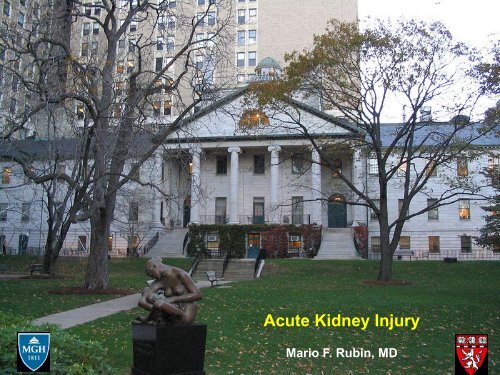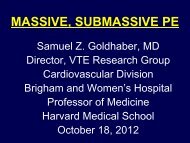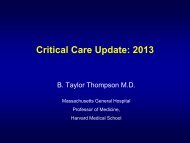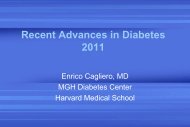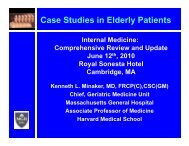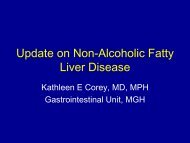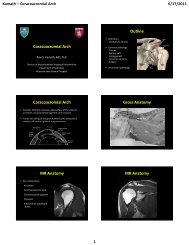Acute Kidney Injury
Acute Kidney Injury
Acute Kidney Injury
Create successful ePaper yourself
Turn your PDF publications into a flip-book with our unique Google optimized e-Paper software.
<strong>Acute</strong> <strong>Kidney</strong> <strong>Injury</strong><br />
Mario F. Rubin, MD
Dr. Mario Rubin reports:<br />
•That he does not have any financial<br />
relationships with commercial<br />
entities producing, marketing, reselling,<br />
or distributing health care<br />
goods or services consumed by, or<br />
used on, patients relevant to the<br />
content he is planning, developing,<br />
presenting or evaluating.
<strong>Acute</strong> Renal Failure<br />
It is characterized by a deterioration of renal function<br />
over a period of hours to days, resulting on the failure of<br />
the kidneys to excrete nitrogenous wastes and to<br />
maintain electrolyte and acid-base balance.<br />
When one attempts to review the subject of acute renal<br />
failure, one is immediately struck by the confusion in<br />
terminology and wide disparity in the definitions of<br />
terms.<br />
Thadhani R et al. N Engl J Med 1996;334:1448-1460
AKIN Diagnostic Criteria For AKI<br />
A reduction within 48 hours of kidney function, currently<br />
defined as:<br />
1. An absolute increase of serum creatinine of more<br />
than or equal to 0.3 mg/dL<br />
2. A percentage increase of serum creatinine of more<br />
than or equal to 50% (1.5 fold from baseline)<br />
3. A reduction in urine output (documented oliguria of<br />
less than 0.5 mL/Kg/Hour for more than six hours)<br />
Metha RL et al. Crit Care.2007;11:R31
Phases of Post-Ischemic AKI<br />
GFR<br />
Serum Creatinine<br />
Time
AKIN Conceptual Model<br />
for <strong>Acute</strong> <strong>Kidney</strong> <strong>Injury</strong><br />
Normal<br />
Increased<br />
risk<br />
Damage<br />
↓ GFR<br />
<strong>Kidney</strong><br />
failure<br />
Death<br />
Ideal<br />
Biomarker<br />
Creatinine
Coca SG et al. KI 2008;73:1008-1016
AKI: the Growing Threat<br />
BEST Epidemiology Study<br />
(N: ~ 30,000 patients from 54 hospitals in 23 countries)<br />
• 1/3 to 2/3 of patients admitted to the ICU<br />
will develop acute kidney injury (AKI)<br />
• 6% of all critically ill patients will lose<br />
kidney function completely<br />
• 70% of these patients will require dialysis<br />
• 60% will die<br />
Uchino S et al. JAMA 2005;294:813-818
MMWR 2008; 57:0309-312
MMWR 2008; 57:0309-312
Mean Hospital Costs Associated With<br />
Changes In Serum Creatinine<br />
Chertow, G. M. et al. J Am Soc Nephrol 2005;16:3365-3370
Mortality Associated With Change In Serum<br />
Creatinine<br />
Chertow, G. M. et al. J Am Soc Nephrol 2005;16:3365-3370
Natural History of AKI<br />
Cerda, J. et al. Clin J Am Soc Nephrol 2008;3:881-886
Distant Organ <strong>Injury</strong> Caused By AKI<br />
Scheel PS et al. KI.2008;74:849-851
Classification of the Etiologies of<br />
<strong>Acute</strong> <strong>Kidney</strong> <strong>Injury</strong><br />
<strong>Acute</strong><br />
<strong>Kidney</strong><br />
<strong>Injury</strong><br />
Prerenal<br />
AKI<br />
Intrinsic<br />
AKI<br />
Postrenal<br />
AKI
Classification of the Etiologies of<br />
<strong>Acute</strong> <strong>Kidney</strong> <strong>Injury</strong><br />
<strong>Acute</strong><br />
<strong>Kidney</strong><br />
<strong>Injury</strong><br />
Prerenal<br />
AKI<br />
Intrinsic<br />
AKI<br />
Postrenal<br />
AKI<br />
<strong>Acute</strong><br />
Tubular<br />
Necrosis<br />
<strong>Acute</strong><br />
Interstitial<br />
Nephritis<br />
<strong>Acute</strong><br />
GN<br />
<strong>Acute</strong><br />
Vascular<br />
Syndromes<br />
Intratubular<br />
Obstruction
Hou SH, et al. Am J Med 1983; 74:243-248<br />
Kaufman J, et al. Am J <strong>Kidney</strong> Dis 1991; 17:191-198<br />
Epidemiology of AKI
<strong>Acute</strong> Tubular Necrosis
Urine Microscopy Is Associated with Severity and Worsening<br />
of <strong>Acute</strong> <strong>Kidney</strong> <strong>Injury</strong> in Hospitalized Patients<br />
Perazella MA et al. CJASN 2010;5:402-408
The Urinary Indexes<br />
Schrier, R. W. et al. J. Clin. Invest. 2004;114:5-14
Pathogenesis of Prerenal Azotemia<br />
Volume<br />
Depletion<br />
Angiotensin II<br />
+<br />
Adrenergic nerves<br />
+<br />
Vasopressin<br />
+<br />
Congestive<br />
Heart Failure<br />
Reduced<br />
Renal<br />
Perfusion<br />
Decreased<br />
GFR<br />
Liver<br />
Failure<br />
-<br />
Sepsis<br />
-<br />
Nitric oxide<br />
Prostaglandins
Normal and Impaired Autoregulation of the<br />
Glomerular Filtration Rate during Reduction of<br />
Mean Arterial Pressure<br />
Abuelo J. N Engl J Med 2007;357:797-805
Intrarenal Mechanisms for Autoregulation of the Glomerular<br />
Filtration Rate under Decreased Perfusion Pressure and<br />
Reduction of the Glomerular Filtration Rate by Drugs<br />
Abuelo J. N Engl J Med 2007;357:797-805
AKI in Liver Disease<br />
Pre-renal Azotemia<br />
Hepatorenal Syndrome<br />
<strong>Acute</strong> Tubular Necrosis<br />
Interstitial Nephritis<br />
Glomerular Syndromes<br />
• IgA nephropathy<br />
• Cryoglobulinemia<br />
• MPGN<br />
• Membranous nephropathy
Revised Diagnostic Criteria<br />
for Hepatorenal Syndrome<br />
Cirrhosis with ascites<br />
Serum creatinine >1.5 mg/dl<br />
No improvement of serum creatinine after at least 2 days with<br />
diuretic withdrawal and volume expansion with albumin (1 g/kg/day<br />
up to 100 g/day)<br />
Absence of shock<br />
No current or recent treatment with nephrotoxic drugs<br />
Absence of parenchymal kidney disease as indicated by proteinuria<br />
>500 mg/day, hematuria (>50 RBC/hpf) and/or abnormal renal<br />
ultrasound<br />
Salerno F, et al. Gut 2007; 56: 1310-1318
Forms of Hepatorenal Syndrome<br />
Type 1: Doubling of serum creatinine to a level<br />
of >2.5 mg/dL or a reduction in creatinine<br />
clearance by 50% or more to a value of < 20<br />
mL/min over a duration of < 2 weeks<br />
Type 2: Moderate and stable reduction in renal<br />
function
Survival in Type 1 and Type 2<br />
Hepatorenal Syndrome<br />
Gines P, et al. Lancet 2003; 362: 1819-827
Treatment of Hepatorenal Syndrome<br />
Liver transplantation<br />
Vasoconstrictors:<br />
‣ Terlipressin<br />
‣Norepinephrine<br />
‣Midodrine / Octreotide<br />
Transjugular intrahepatic portosystemic shunting (TIPS)<br />
Renal replacement therapy as bridge therapy<br />
Extracorporeal liver assist device (ELAD)
Abdominal Compartment Syndrome<br />
• Definitions<br />
‣Intra-abdominal hypertension:<br />
intra-abdominal pressure ≥12 mm Hg; or<br />
abdominal perfusion pressure (MAP-IAP)
Systemic Effects<br />
Renal Effects<br />
Decreased APP and<br />
Mesenteric venous outflow<br />
j tlntracinal Pressure rt<br />
~~:~~~~~~<br />
Elevated Diaphragm<br />
1' Intrathoracic pressure<br />
1' PIP<br />
1' Dead space<br />
1' PaC02<br />
.t.Pa02<br />
( Cardiovascular I<br />
Hypovolemia<br />
.t. Venous return<br />
tCVP<br />
1'PAOP<br />
1'SVR<br />
.t.CO<br />
.<br />
(vi, cycle) ) pe USion J------1--'<br />
Bowel ischemiaflnflammation<br />
Bacterial translocation<br />
Cytokine release<br />
Capillary leak & edema<br />
Portal blood flow<br />
Clinical Effects<br />
Oliguria<br />
Decreased G FR<br />
Proteinuria<br />
worsening of ischemic injury<br />
Diuretic resistance<br />
Proposed Mechanisms<br />
of Renal Dysfunction<br />
Increased renal vein pressure<br />
lrculatlon<br />
Microvascular congestion<br />
Renal vascular resistance<br />
Increased Catecholamines<br />
Increased Angiotensin II<br />
Proinflammatory cytokines<br />
Increased lntracapsular pressure<br />
(in ischemic injury)
Abdominal Compartment Syndrome<br />
• Clinical settings<br />
‣ Trauma patients following massive volume resuscitation<br />
‣ Post liver transplant<br />
‣ Mechanical limitations to the abdominal wall:<br />
Tight surgical closure<br />
Burn injuries<br />
‣ Bowel obstruction<br />
‣ Pancreatitis<br />
• Diagnosis<br />
‣ Measurement of intra-abdominal pressure via transduction of bladder<br />
pressure<br />
• Treatment<br />
‣ Abdominal decompression
<strong>Acute</strong> Tubular Necrosis
<strong>Acute</strong> Tubular Necrosis<br />
• Ischemic<br />
‣ prolonged prerenal azotemia<br />
‣ hypotension<br />
‣ hypovolemic shock<br />
‣ cardiopulmonary arrest<br />
‣ cardiopulmonary bypass<br />
• Sepsis<br />
• Crystal<br />
‣ Antivirals<br />
‣ MTX<br />
‣ Sulfas<br />
‣ Quinolones<br />
• Nephrotoxic<br />
‣ drug-induced<br />
radiocontrast agents<br />
aminoglycosides<br />
amphotericin B<br />
cisplatinum<br />
acetaminophen<br />
‣ pigment nephropathy<br />
hemoglobin<br />
myoglobin
Pathogenesis of Ischemic ARF<br />
Ischemia<br />
Endothelial <strong>Injury</strong><br />
Tubular <strong>Injury</strong><br />
Disruption of Cytoskeleton<br />
Activation of Vasoconstrictors<br />
Impaired Vasodilation<br />
Increased Leukocyte Adhesion<br />
Inflammation<br />
Loss of Cell Polarity<br />
Apoptosis<br />
&<br />
Necrosis<br />
Capillary Obstruction<br />
&<br />
Continued Ischemia<br />
Desquamation of Cells<br />
Tubular Obstruction<br />
&<br />
Backleak
Risk Factors for<br />
Contrast-Induced Nephropathy<br />
• Patient Related<br />
‣ Preexisting renal insufficiency<br />
‣ Diabetes mellitus<br />
‣ Intravascular volume depletion<br />
‣ Reduced cardiac output<br />
‣ Concomitant nephrotoxins<br />
• Procedure related<br />
‣ Increased dose of radiocontrast<br />
‣ Multiple procedures within 72 hours<br />
‣ Intra-arterial administration<br />
‣ Type of radiocontrast
Prevention of<br />
Contrast-Induced Nephropathy<br />
• Identify high risk patients<br />
• Volume expand with isotonic sodium chloride or sodium<br />
bicarbonate<br />
‣ Optimal fluid composition and timing and rate of fluid<br />
administration remain uncertain<br />
• Use low osmolar or iso-osmolar contrast in high-risk population<br />
• N-acetylcysteine<br />
‣ Although data are inconclusive, NAC is inexpensive and safe<br />
• Discontinue NSAIDs and vasoconstrictors
A Risk Score To Predict Contrast-Induced<br />
Nephropathy<br />
http://www.zunis.org/Contrast-Induced%20Nephropathy%20Calculator2.htm
Major Categories and Commonly Reported Causes of<br />
Rhabdomyolysis<br />
• Genetic:<br />
‣ Disorders of glycolysis<br />
‣ Disorders of lipid metabolism<br />
‣ Mitochondrial disorders<br />
• Trauma<br />
• Exertion<br />
• Muscle hypoxia:<br />
‣ Arterial occlusion<br />
‣ Prolonged immobilization<br />
• Metabolic and electrolyte disorders:<br />
‣ Hypokalemia<br />
‣ Hypocalcemia<br />
‣ Hypophosphatemia<br />
‣ Hyperosmolar states<br />
‣ DKA<br />
• Infections:<br />
‣ Influenza A & B<br />
‣ Legionella<br />
‣ HIV<br />
‣ EBV<br />
‣ Coxsackievirus<br />
‣ Clostridum<br />
‣ Streptococci<br />
‣ Staphylococcus aureous<br />
• Body temperature changes<br />
• Drugs and toxins<br />
‣ Statins<br />
‣ Fibrates<br />
‣ ETOH<br />
‣ Heroin, Cocaine<br />
• Idiopathic<br />
Bosch X et al. N Engl J Med 2009;361:62-72
Prevention of Myoglobinuric AKI<br />
• Standard management recommendations<br />
‣Aggressive intravenous fluids<br />
‣Bicarbonate<br />
‣Mannitol
<strong>Acute</strong> Interstitial Nephritis<br />
• Fever<br />
• Rash<br />
• Eosinophilia<br />
• Sterile pyuria<br />
• Eosinophiluria<br />
• White cells casts<br />
• Tubular dysfunction
<strong>Acute</strong> Interstitial Nephritis<br />
• Drug-induced:<br />
‣ penicillins<br />
‣ cephalosporins<br />
‣ sulfonamides<br />
‣ rifampin<br />
‣ phenytoin<br />
‣ furosemide<br />
‣ proton pump inhibitors<br />
‣ NSAIDs<br />
• Malignancy<br />
• Idiopathic<br />
• Infection-related:<br />
‣ bacterial<br />
‣ viral<br />
‣ rickettsial<br />
‣ tuberculosis<br />
• Systemic diseases:<br />
‣ SLE<br />
‣ sarcoidosis<br />
‣ Sjögren’s syndrome<br />
‣ tubulointerstitial nephritis<br />
and uveitis
<strong>Acute</strong> Interstitial Nephritis:<br />
Treatment<br />
Discontinue offending drug<br />
Treat underlying infection<br />
Treat systemic illness<br />
Glucocorticoid therapy:<br />
recommended in patients who fail to respond to<br />
more conservative therapy<br />
no RCTs have been reported
<strong>Acute</strong> Vascular Syndromes<br />
• Macrovascular<br />
‣ Renal artery<br />
thromboembolism<br />
‣ Renal artery dissection<br />
‣ Renal vein thrombosis<br />
• Microvascular<br />
‣ Atheroembolic disease
Atheroembolic Disease<br />
• Risk factors<br />
‣ Atherosclerosis<br />
‣CAD<br />
‣AAA<br />
‣PVD<br />
‣ Hypertension<br />
‣ Hypercholesterolemia<br />
‣ Diabetes Mellitus<br />
• Precipitating factors<br />
‣ Arterial catheterization<br />
‣ Arteriography<br />
‣ Vascular surgery<br />
‣ Anticoagulation<br />
‣ Thrombolytic therapy
<strong>Kidney</strong><br />
Skin<br />
<strong>Acute</strong>, subacute, and chronic renal failure<br />
Severe uncontrolled hypertension<br />
Renal infarction<br />
Livedo reticularis<br />
Blue toe syndrome<br />
Ulceration and gangrene<br />
Purpura<br />
Gastrointestinal syst em<br />
Abdominal pain<br />
Gastrointestinal bleeding<br />
Bowel ischaemia, infarction, and obstruction<br />
Pancreatitis, cholecystitis, and abnormal liver tests<br />
Splenic infarcts<br />
H eart<br />
Myocardial ischaemia<br />
Myocardial infarction<br />
Central n ervou s system<br />
Transient ischaemic attacks<br />
Eye<br />
Amaurosis fugax<br />
Altered mental status<br />
Cerebral infarction<br />
Spinal cord infarction<br />
Retinal emboli (Hollenhorst plaques)<br />
Systemic sign s<br />
Fever<br />
Weight loss<br />
Malaise<br />
Myalgia<br />
Anorexia
Atheroembolic Disease:<br />
Laboratory Features<br />
• Serum chemistries<br />
‣ ⇑BUN and creatinine<br />
‣ ⇑Amylase<br />
‣ ⇑CPK<br />
‣ ⇑LFTs<br />
• Hematology<br />
‣ Leukocytosis<br />
‣ Eosinophilia<br />
‣ Anemia<br />
‣ Thrombocytopenia<br />
• Serologic<br />
‣ ⇑ESR<br />
‣ ⇓Serum complement<br />
• Urine<br />
‣ Eosinophiluria<br />
‣ Proteinuria (may be in the<br />
nephrotic range)<br />
‣ Hematuria<br />
‣ Pyuria
Atheroembolic Disease:<br />
Avoid anticoagulation<br />
Treatment<br />
Avoid vascular interventions<br />
ACE inhibitors / angiotensin receptor blockers<br />
Statin therapy<br />
Nutrition support<br />
Dialysis for management of volume status and<br />
uremia<br />
Role of steroid therapy is uncertain
Prevention and Treatment of AKI<br />
• Volume expansion<br />
• Avoid hypotension<br />
• Prevent sepsis<br />
• Discontinue nephrotoxins<br />
• Nutrition
Pharmacological Interventions in <strong>Acute</strong> <strong>Kidney</strong> <strong>Injury</strong><br />
Drug<br />
Biological<br />
rationale<br />
Animal<br />
experiments<br />
Uncontrolled<br />
human data<br />
Small<br />
RCT<br />
Large<br />
RCT<br />
Loop diuretics Present Favorable Favorable Negative N/A<br />
Low-dose dopamine Present Favorable Favorable Variable Negative<br />
Mannitol Present Favorable Favorable N/A N/A<br />
The only FDA<br />
Ca antagonist Present Favorable Favorable Variable N/A<br />
Theophylline Present Favorable Favorable Positive N/A<br />
approved treatment for<br />
Prostaglandins Present Favorable Favorable N/A N/A<br />
established AKI<br />
Natriuretic peptide Present Favorable Favorable Negative N/A<br />
α-receptor antagonist Present N/A N/A Positive N/A<br />
is dialysis<br />
Endothelin antagonist Present Favorable N/A N/A N/A<br />
Thromboxane antagonist Present Favorable N/A N/A N/A<br />
Thyroxine Present Favorable N/A Negative N/A<br />
Saline Present Favorable Favorable Positive N/A<br />
NAC Present Favorable N/A Positive N/A<br />
Non-ionic media Present Favorable Favorable Positive positive<br />
C. Ronco and R.Bellomo Nephron Clinical Practice 93:C13, 2003
Diuretic Therapy in ATN<br />
Mehta RL, et al. JAMA 2002; 288:2547-2553
Renal Replacement Therapy<br />
in AKI<br />
• Timing:<br />
‣Medically intractable volume overload, acidemia,<br />
hyperkalemia<br />
‣Overt uremic manifestations<br />
• Modality:<br />
‣Continuous: CVVH, CVVHD, CVVHDF<br />
‣Intermittent: IHD<br />
‣Hybrids: SLED<br />
• Dosing: Is more merrier
Current data do not suggest a benefit of<br />
CRRT as compared with IHD with regard<br />
to either survival or recovery of renal function.<br />
There are no data comparing outcomes<br />
with the "hybrid" modalities with<br />
either CRRT or IHD. There is increasing<br />
evidence that higher dosages of RRT in<br />
AKI are associated with improved outcomes;<br />
however, results have not been<br />
consistent across all studies. Two large<br />
multicenter, randomized trials to address<br />
this issue are ongoing.
Dose of RRT in AKI:<br />
The ATN Study<br />
The RENAL Study<br />
P=0.47<br />
Palevsky PM, et al. N Engl J Med 2008; 359:7-20<br />
Bellomo R, et al.<br />
N Engl J Med 2009;361:1627-1638
The BEST <strong>Kidney</strong> (Beginning and Ending Supporting Therapy for<br />
the <strong>Kidney</strong>) study<br />
• The development of ARF in the ICU is a<br />
relatively common occurrence<br />
• Of those patients who develop ARF in the<br />
ICU, the majority require renal<br />
replacement therapy<br />
• Chronic kidney disease is a major risk<br />
factor for the development of ARF
The BEST <strong>Kidney</strong> (Beginning and Ending Supporting Therapy for<br />
the <strong>Kidney</strong>) study<br />
• Dependence on chronic dialysis is a common<br />
outcome following ARF in the ICU<br />
• CRRT is the most commonly applied renal<br />
replacement modality for ARF in the ICU<br />
• Despite significant improvements in both<br />
dialysis technology and critical care medicine,<br />
hospital mortality in this population remains<br />
high.
Thank you for your attention<br />
mfrubin@partners.org


